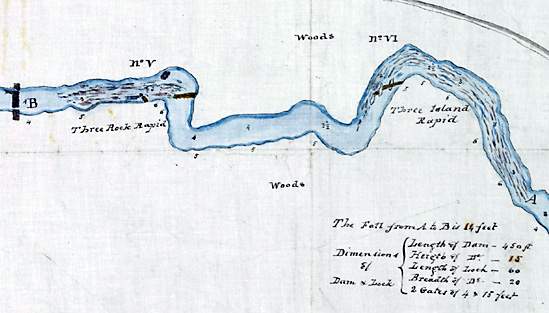A Rapid Ride: The Billings shoot Hogs Back "Falls"
adapted from Robert Legget's "Rideau Waterway"
Robert Legget recounts an anecdotal tale about the only time a canoe shot the falls at Hogs Back:
"In 1814, Mr and Mrs Billings, with their young daughter, Sabra, the first European child to be born in Gloucester Township, were returning from a canoe trip to Merrickville. They came to the portage around the falls at Hog's Back and there met Philemon Wright, who was also canoeing on the river. They talked before disembarking and became so interested in their discussion that nobody noticed that the Billings' canoe was edging towards the current which swept over the falls.
Too late, Philemon Wright shouted his warning but the frail craft with the Billings family in it was caught in the swift water and carried over the falls before the eyes of Wright's horrified party. Wright rushed around the short portage road, expecting to find battered bodies and a wrecked canoe. Instead he found the canoe afloat and Bradish Billings still in control of it, his wife safe with the baby quiet in her arms.
This is believed to have been the only occasion on which a canoe shot the Hog's Back Falls; even the most experienced Indian travellers would never attempt the feat. It is a measure of the character and skill of Bradish Billings as a woodsman that he was able to save his family by his handling of the canoe in this emergency." [Legget, p.219]
The Facts
Is this story true? Well, some parts of the story probably are, but some parts clearly aren’t.
Hogs Back is one of the more spectacular examples of the landscape changes brought about by the building of the Rideau Canal. It is the spot where the navigation route leaves the Rideau River and proceeds through a canal cut (partly using pre-existing ravines – it’s not all man-made) to the Ottawa River. The canal dam at Hogs Back was to do two things – it was to flood the Rideau River all the way to Black Rapids, to put a navigation depth of water over the lower sill of the lock at Black Rapids, and it was also to put water over the upper sill at Hogs Back, the entrance to the canal cut to the Ottawa Locks. This called for a big dam, in the end (with many difficulties, but that’s another tale – see “Washed Away”), it raised the Rideau River at this spot by 41 feet (12.5 m).
The dam is built on the head of the original rapids (not falls) which were known as Three Rock Rapids. These rapids dropped about 6 feet (1.8 m) over a distance of 2,000 feet (610 m). Natives, surveyors and voyageurs navigated them by getting out of their canoes and pulling or lining them up or down the rapids. So where did the falls come from?
 |
| Section of Joshua Jebb's 1816 MapThis map shows both Three Rock Rapids (today's Hogs Back) and Three Island Rapids (now underneath the head of Mooneys Bay). Jebb notes that the total drop of these two rapids (from his marked A on the right to B on the left) is 14 feet. Of this, the Hogs Back portion of the rapids accounted for about 6 feet of that drop. |
The falls we see today are the 41 feet of raised water rushing through a man-made waste water channel (a by-wash), excavated in the east bank of the river during the building of the Rideau Canal. Canal construction-era maps label this channel as a “waste channel” and “excavated for bye [by-wash] channel.” With this in mind, a visitor to Hogs Back can now clearly see that these are man-made falls.
Hogs Back Falls
Today’s falls are water rushing through a man-made waste water channel
excavated during the construction of the Rideau Canal. photo by: Ken W. Watson.
Returning to the Billings story, how much is true if there were no falls at this location in 1814? The basics of the story are likely quite true. There was a 2,000 foot long set of rapids, which dropped about 6 feet over that distance, with lots of rocks in the middle. While the Hogs Back dam is hiding the top portion of the original rapids, the lower portion of the rapids is still visible, you can see them today.
Although voyageurs and surveyors (and most natives) didn’t portage these rapids, it is likely that a portage was developed for those less adventuresome, such as the Billings family. Local settlers were using smaller, more easily portaged canoes, unlike the large freighter canoes which the surveyors and voyageurs would pull or line up and down the rapids. Surveyor John Burrows once described being up to his armpits in water as he dragged his canoe up a set of rapids – obviously the more genteel wouldn’t want to do this.
So, “regular folk” would have portaged these rapids and one can quite imagine that it was with a great deal of horror that Wright watched the canoe with the poor Billings family get swept down the rapids. The “fun” of white water canoeing wasn’t a concept developed until the 20th century.
The Rapids Today
The lower section of rapids at Hogs Back today is very similar
to what the Billings would have run. Photo by: Ken W. Watson.

Sources:
"Rideau Waterway", by Robert Legget, University of Toronto Press, Toronto, 1986
"The Rideau Route" by Ken W. Watson, Elgin, 2007
|